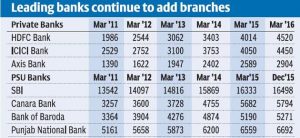Branch Expansion Spree/Consolidation: A Retrospective Narrative
Financial inclusion has been a hot topic in India for more than a decade now. Enabling availability of banking services to the rural and urban population of India led to a branch expansion spree by all banks operating in India. As a result of such policies then, in 2011-12 there was an addition of around 5,000 public sector bank branches while in 2006-07 and 2008-09 such expansion amounted to 1,500 and 2,400 branches respectively. In the light of the finance ministry’s consolidation and rationalisation strategy, such hurried brick and mortar expansion approach can now be a lesson learnt in retrospect.

As of 2012, when the penetration of banks was severely lacking, an average branch serviced around 13,000 customers, indicating the demand for services and the potential available, which was also corroborated by RBI reports that stated that nearly 60 per cent of the population did not have access to banking services. Based on this logic, the supply-side financial inclusion solution of branch expansion seemed the best way out- and the quickest. The branch expansion spree as a national movement delivered a happy increase in numbers when looked at in isolation, but when you look at the same on a per unit basis with respect to viability, costs and sustainability, many of these bank branches fail to make the cut.
According to the 2011 Census, 96 per cent of Indian villages have a population of less than 1,000. This then changes the landscape of such expansion and its results and effects. With these kinds of demographics at the granular levels, the shaky foundation of the expansion spree remained hidden. The repercussions of these have cropped up now, instigating consolidation and final calls on closing some unviable operations. As part of capital saving exercise, the banks have been advised to pursue closure of loss making domestic and international branches so they can focus on the markets that realise maximum returns. Capital conservation and economies of scale is now coming up at the forefront to ensure operational viability. Instead, this should have been the premise while executing any locational expansion.
Considering the branch expansion spree was a supply-side policy, it still cannot be executed in isolation from local demand. Branch expansion happens at the micro-regional levels, the landscape of which differs across and within states and from urban areas. A one-market strategy cannot be expected to yield maximum returns from all such branches then. The expansion needs to be in tandem with how the local economy looks like, the potential demands, the infrastructure it possesses and many detailed parameters within these components. In technical lingo, this concept is known as geo-profiling, a sub-part of locational analytics. Even though these developments come in retrospect, the same technology and data can be harnessed to ensure efficient decision making in terms of market expansion and continuation.
Such locational analytics processes can be combined with artificial intelligence and machine learning to provide granular level geographical solutions. As a part of previous projects undertaken by Quantta Analytics, a data analytics platform company, India’s banked and unbanked areas were analysed at micro-regional catchment area, grid and ward levels and ranked on economic viability or attractiveness. The insights derived from such studies generate unparalleled local context of existing industry competition, current and future area potential, demands and characteristics of each of these units analysed. If such insights were available or could be even partially harnessed before making expansion decisions, maybe the scenario would not have been as bad today. Nevertheless, it is not too late to start adapting to a data-driven scientific approach of decision-making.
